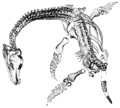Talk:Uintatherium
Uintatherium is currently an Earth sciences good article nominee. Nominated by Borophagus (talk) at 20:34, 11 November 2025 (UTC) Any editor who has not nominated or contributed significantly to this article may review it according to the good article criteria to decide whether or not to list it as a good article. To start the review process, click start review and save the page. (See here for the good article instructions.)
Short description: Extinct genus of mammals |
| This It is of interest to the following WikiProjects: | |||||||||||||||||||||
| |||||||||||||||||||||
| This article contains a translation of Uinitatherii from ca.wikipedia. |
Size
[edit]The article says that Uintatherium was the size of a Rhino, but rhinos vary widely in size. The High Fin Sperm Whale (talk) 21:42, 10 March 2009 (UTC)
- Yeah, wellll... to within an order of magnitude, all rhinos are the same linear size, like all humans. But few people even know about the Sumatran rhino. But with the smallest rhino massing nearly a tonne, and the largest less than 4 tonnes, I reckon it gives us not too bad an idea of whether any animal you trip over is likelier to be a uintatherium or a goat. Anyway, the article gives an estimate of about 2.5 tonnes, which sounds like a good average rhino, no? JonRichfield (talk) 08:21, 21 December 2012 (UTC)
Marshy browsers
[edit]I have not changed the text, yet, but I am bothered by a couple of apparently contradictory statements. Consider: "...a large browsing animal..." and "...the aquatic plants from marshes that seem to have comprised their diet...". I could of course re-word the text to emphasise the unusualness of a diet of marshes, but more importantly, since when is an animal that eats aquatic plants from marshes a browser? I think that text need re-thinking plus some citations. What do uintatherium cheek teeth look like? Hmmm... I see that online Britannica say: "The teeth were also distinctive: males of the genus possessed large, powerful canines; incisors were absent in the upper jaw but present in a reduced state in the lower; and the upper molars were characterized by V-shaped crests." That sounds more like browser than marsh-eater to me. See http://www.britannica.com/EBchecked/topic/612818/Uintatherium . But I am no palaeontologist. Mind you, I went looking and found a remarkably interesting site: http://faculty.baruch.cuny.edu/jwahlert/enamel/schmelz.html Ooooh boyyy... Distraction alert! The more I look the more I find that needs attention! I'm outta here for now! JonRichfield (talk) 08:21, 21 December 2012 (UTC)

